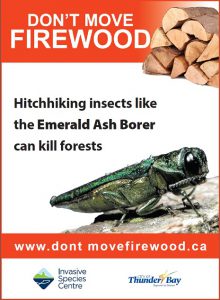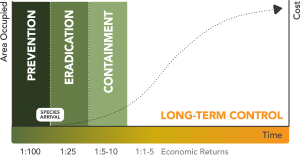Prevention is the most effective and low-cost solution for managing invasive species. Waiting until an invasive species is established to start management is costly and can harm valuable infrastructure and the natural biodiversity needed for healthy ecosystems.
Stopping the arrival of an invasive species in the most effective way to manage it. Invasive species can be difficult to get rid of and can have severe consequences on the natural areas around them once they become established. It can also be very expensive to treat and to try to eradicate an invasive pest once it has established in a new area. Taking the time to invest in education, research, and other prevention strategies helps to avoid the more extensive economic, environmental, and social costs that can be caused by established forest invaders in the long-run (Ontario Ministry of Natural Resources, 2012)

Education
- Property managers and owners should strive to educate property users about invasive species and about ways to prevent them. Educational posters, pamphlets, info sheets, or websites explaining the invasive species of the area and ways to avoid introduction or spread of these or new pests should be developed and offered at all access points.
- Communication strategies about high-risk pathways should be implemented to educate the public about activities that could allow for introduction or spread of invasive pests. As more and more people know about invasive species risks involved with introduction pathways, more of them can take precautions to prevent introductions through those pathways.
Research
- Continued research focused on how species become invasive, about introduction pathways, and to better understand the conditions that lead to the spread of invasive species can help to prevent further introduction and spread of forest pests.
- Scientific research on the biology of invasive species can also explore their movement patterns and lifecycles. This, along with knowledge of environmental conditions and pathways, allows for a better understanding of the likelihood of potential introduction of a pest into a new area (Ontario Ministry of Natural Resources, 2012).
- Research focusing on the potential environmental, social, and economic consequences of an established species can show the costs associated with pest outbreaks. Weighing these costs against the costs of prevention, can illustrate the advantage of undertaking prevention strategies rather than only responding to pests once they are already established. Prevention costs are often much lower than the costs of damage from forest pests and costs of treatment once they have become established.
- Research to better understand the impact of climate change on invasive species can also help to prevent and control additional pest outbreaks in the future (Ontario Ministry of Natural Resources, 2012).
More Information
- Forest management plans should ultimately strive to protect healthy ecosystems and should include measures to protect biodiversity, rehabilitate degraded areas, and build ecosystem resilience. Healthy ecosystems are better able to cope with disturbances, such as invasive forest pests (Ontario Ministry of Natural Resource, 2012).
- Related forestry activities, such as field work, road work, cut block development, harvesting, and site preparation, should take place in areas free of forest pest infestations, if possible. If forestry work in known infested areas is unavoidable, work should be scheduled in uninfested areas before moving to infested areas. Then once work is complete in infested sites, all boots, equipment, and vehicles should be thoroughly cleaned to avoid accidentally moving forest pests to new areas (Province of British Columbia, 2013).
- As disturbed areas are more susceptible to forest pest infestations, these sites should be replanted as soon as possible. Planting native trees in high density on a recently harvested site could help to reduce the likelihood of invasive forest plants from moving into the area (Province of British Columbia, 2013).
- Municipalities, provinces, and countries should all work to develop monitoring and early detection strategies to prevent the entry of invasive forest pests into new areas and across borders. Monitoring, especially when a known forest pest is already in an adjacent area, can help to quickly identify new invasive species before they can spread (OMNRF, 2014).
- When traveling from one area to another, it is best for everyone to take as many precautions as possible to ensure invasive species are not stowing away for the ride to a new location.
- Do not import firewood, plants, foods, or animals from other countries without declaring them at the border. Many of these products are restricted or prohibited items, and are thus not allowed into the country. For example, you cannot import firewood from any country except from some parts of the United States. You could also face penalties or prosecution if you do not declare restricted or prohibited items, such as firewood (CFIA, 2013).

